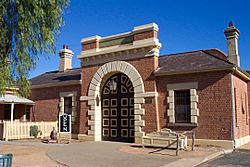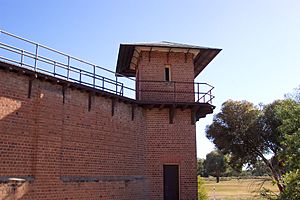Wentworth Gaol facts for kids

The gatehouse of the Wentworth Gaol (1881 – 1927)
|
|
| Location | 112 Beverley Street, Wentworth, New South Wales |
|---|---|
| Coordinates | 34°06′09″S 141°54′48″E / 34.1026°S 141.9134°E |
| Status |
|
| Opened | 1881 |
| Closed | 1 July 1928 |
| Managed by |
|
| Official name | Old Wentworth Gaol; Wentworth Gaol (former) |
| Type | State heritage (complex / group) |
| Designated | 21 October 2016 |
| Reference no. | 1982 |
| Type | Gaol/Lock-up |
| Category | Law Enforcement |
| Builders | Whitcombe Brothers, Hay |
The Old Wentworth Gaol is a historic building in Wentworth, New South Wales, Australia. It used to be a prison (called a gaol) and later a school. Today, it's a museum where you can learn about its past.
This special building is located at 112 Beverley Street. It was designed by James Barnet and built between 1879 and 1881. The land is owned by the New South Wales Government. The Old Wentworth Gaol is so important that it was added to the New South Wales State Heritage Register in 2016.
Contents
Exploring the History of Wentworth Gaol
The area around the Murray River and Darling River has a very long history. For thousands of years, it was the traditional home of the Paakantyi and Maraura Aboriginal peoples. They have a rich cultural heritage in this region.
Early European Explorers and Settlement
In 1829, Charles Sturt was the first European explorer to travel through this area. He followed the Murrumbidgee River to where it met the Murray River, and then to the Darling River. Sturt met many Aboriginal people during his journey.
Later, in 1836, another explorer named Thomas Mitchell explored the Darling River. During his trip, there were some conflicts between his group and Aboriginal people.
By 1838, people like Joseph Hawdon and Charles Bonney started moving cattle from New South Wales to Adelaide. They often camped near where the Murray and Darling Rivers meet. This spot became known as Hawdon's Ford.
As more Europeans arrived, conflicts sometimes happened with the Aboriginal people. Their traditional lands were being used by the newcomers.
How Wentworth Town Began
In the 1840s, farmers started settling along the Darling and Murray Rivers. A place called Moorna Station became important for government activities in the area.
The settlement at Hawdon's Ford was officially named Wentworth in 1859. It was named after William Wentworth, a famous explorer and politician.
The First Ways to Keep Prisoners
Before the gaol was built, prisoners in Wentworth were kept in simple ways. One early method was chaining them to a large tree trunk! Later, a small slab hut was used as a lockup. This hut was declared a prison in 1870.
By the 1860s, the lockup was too small and crowded. Reports described the conditions as "disgraceful" and "shameful." It was clear that a new, proper gaol was urgently needed.
Building the New Wentworth Gaol
In 1877, plans began for a new gaol. The government wanted it to be similar to other new gaols being built at the time.
The gaol was built between 1879 and 1881 by Whitcombe Bros. The bricks were made locally. Special blue stone from Victoria was brought in for parts of the building.
The new gaol was carefully designed by colonial architect James Barnet. It included:
- A large courtyard area.
- A cell block with ten cells for men and two for women.
- A kitchen for preparing meals.
- A hospital room.
- Storage areas.
- A home for the gaol warden.
- Two observation towers for guards.
The gaol even had a library for prisoners. At its busiest, it held up to 18 prisoners and had three warders (guards).
Why the Gaol Closed
Over time, other gaols were built in nearby towns like Silverton and Broken Hill. This meant there was less need for the Wentworth Gaol.
The gaol officially closed in 1928. The last two prisoners were moved to Broken Hill Gaol in February 1928.
New Uses for the Old Gaol
After closing as a prison, the building found new life.
- In 1935, the hospital section was changed into extra classrooms for Wentworth Central School. Over a hundred students used the gaol building!
- In 1963, the students moved to new classrooms.
- The gaol was briefly used again in 1962 during some problems in Mildura.
Since the mid-1970s, the Old Wentworth Gaol has been restored. Today, it is a popular tourist attraction. Visitors can explore the old cells and learn about its history. The old gaoler's residence is now a shop.
What the Wentworth Gaol Looks Like
The Wentworth Gaol is a single-storey building made of brick with blue stone details. It was designed by James Barnet. It sits on the edge of Wentworth town.
The buildings have sloping slate roofs and are surrounded by a tall, four-meter-high brick wall. The entrance is quite grand, with special stone decorations. Just inside the doors are two offices for guards. The gaoler's house is attached near the entrance.
At each corner of the compound walls, there is a watchtower with a small walkway. Inside the walls, there are two main buildings:
- The rectangular Cell Block, which has 10 cells for men and 2 for women.
- The L-shaped Hospital Wing.
The buildings are made of strong, locally-made bricks. The roofs are covered with Welsh slate. The wood used for doors, windows, and floors is painted Murray pine. There is also a well in the courtyard that collected rainwater.
How the Gaol is Kept Today
The gaol is in excellent condition. Over the last 20 years, a lot of work has been done to restore and maintain it. This includes fixing roofs, improving drainage, and painting.
The Old Wentworth Gaol is now a popular place for tourists to visit. It is open for public tours from Monday to Friday.
Changes Over Time
The gaol still looks very much like it did when it was first built. The biggest change was to the hospital block in 1935. When it became a school, some inside walls and a chimney were removed.
Many restoration projects have taken place since the 1970s to keep the gaol in good shape for future generations.
Why Wentworth Gaol is a Heritage Site
The Old Wentworth Gaol is very important to the history of New South Wales. It is a "heritage-listed" site because it helps us understand the past.
- A Glimpse into History: It shows us what country gaols were like in the 1800s. These gaols were built as more people settled across New South Wales. Its location in Wentworth also shows how important Wentworth was as a regional center back then.
- Designed by a Famous Architect: The gaol was designed by James Barnet, a very important architect in New South Wales from 1865 to 1890. He designed many famous public buildings, including the General Post Office in Sydney.
- A Unique Design: The Old Wentworth Gaol is a great example of Barnet's "Hay-type" gaol design. It still has its remote, serious, and strong prison feel.
- Learning from the Past: This gaol is a valuable resource for learning about crime, punishment, and life in prisons in the late 1800s and early 1900s. It helps us understand the social and cultural history of prisons in New South Wales.
- A Rare Example: It is a rare and well-preserved example of James Barnet's "Hay-type" gaol.
- A Typical Colonial Prison: The Old Wentworth Gaol shows us the main features of colonial prisons. It helps us understand how people thought about crime and punishment in New South Wales in the 1800s.
See also
- Punishment in Australia



